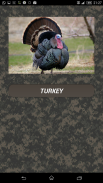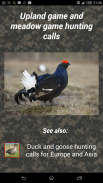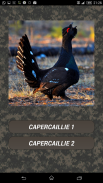







Turkey hunting calls

Beschreibung von Turkey hunting calls
Turkey calls: Hunting sounds Mating calls. program turns your mobile phone into a electronic hunting bird caller . Here you will find the voice of upland fowl and meadow fowl, as well as their image. For best effect can be connected to an external active speaker.
In the library of voices included hunting calls such as:
1. Capercallie call. The western capercaillie (Tetrao urogallus), also known as the wood grouse, heather cock or just capercaillie, is the largest member of the grouse family.
2. Black grouse call. The black grouse or blackgame or blackcock (Tetrao tetrix) is a large game bird in the grouse family. It is a sedentary species, breeding across northern Eurasia in moorland and bog areas near to woodland, mostly boreal. The black grouse is closely related to the Caucasian grouse.
3. Hazel grouse call. The hazel grouse, (Tetrastes bonasia) sometimes called the hazel hen, is one of the smaller members of the grouse family of birds. It is a sedentary species, breeding across northern Eurasia as far east as Hokkaido, and as far west as central and eastern Europe, in dense, damp, mixed coniferous woodland, preferably with some spruce.
4. Willow ptarmigan calls. The willow ptarmigan (Lagopus lagopus) is a bird in the grouse subfamily Tetraoninae of the pheasant family Phasianidae. It is also known as the willow grouse and in the British Isles, where it was previously believed to be a separate species, as the red grouse. It is a sedentary species, breeding in birch and other forests and moorlands in northern Europe, the tundra of Scandinavia, Siberia, Alaska and northern Canada, in particular in the provinces of Newfoundland and Labrador. It is the state bird of Alaska.
5. Partridge calls. Partridges are medium sized non-migratory gamebirds, with a wide native distribution throughout the Old World, including Europe, Asia, and parts of Africa. They are sometimes grouped in the Perdicinae subfamily of the Phasianidae (pheasants, quail, etc.). However, molecular research suggests that partridges are not a distinct taxon within the family Phasianidae, but that some species are closer to the pheasants, while others are closer to the junglefowls.
6. Peasant calls. Pheasants are birds of several genera within the subfamily Phasianinae, of the family Phasianidae in the order Galliformes. The family's native range is restricted to Asia.
7. Turkey calls. The turkey is a large bird in the genus Meleagris, which is native to the Americas. One species, Meleagris gallopavo (commonly known as the domestic turkey or wild turkey), is native to the forests of North America, mainly Mexico and the United States.
8. Woodcock calls. The woodcocks are a group of seven or eight very similar living species of wading birds in the genus Scolopax. Only two woodcocks are widespread, the others being localized island endemics. Most are found in the Northern Hemisphere but a few range into the Greater Sundas, Wallacea and New Guinea. Their closest relatives are the typical snipes of the genus Gallinago.
9. Snipe calls. A snipe is any of about 25 wading bird species in three genera in the family Scolopacidae. They are characterized by a very long, slender bill and crypsis plumage. The Gallinago snipes have a nearly worldwide distribution, the Lymnocryptes snipe is restricted to Asia and Europe and the Coenocorypha snipes are found only in the Outlying Islands of New Zealand.
Write to feedback your suggestions to improve the program. If the program will be in demand may create a hunting calls program with the voices of animals.
Truthahn ruft: Jagdgeräusche Paarungsrufe. Programm verwandelt Ihr Handy in einen elektronischen Jagdvogelrufer. Hier finden Sie die Stimme von Hoch- und Wiesengeflügel sowie deren Bild. Für den besten Effekt kann ein externer Aktivlautsprecher angeschlossen werden.
In der Bibliothek der Stimmen enthalten Jagdanrufe wie:
1. Capercallie anrufen. Das westliche Auerhuhn (Tetrao urogallus), auch bekannt als Auerhahn, Heidehahn oder einfach nur Auerhuhn, ist das größte Mitglied der Auerhahnfamilie.
2. Birkhuhnruf. Das Birkhuhn oder Blackgame oder Blackcock (Tetrao Tetrix) ist ein Großwildvogel in der Familie der Birkhuhn. Es ist eine sesshafte Art, die in Sümpfen und Moorgebieten in der Nähe von Wäldern in ganz Nordeuropa brütet. Das Birkhuhn ist eng mit dem Auerhahn verwandt.
3. Hazel Grouse Call. Das Haselhuhn (Tetrastes bonasia), manchmal auch Haselhuhn genannt, ist eines der kleineren Mitglieder der Familie der Auerhahnvögel. Es handelt sich um eine sesshafte Art, die in Nord-Eurasien bis nach Hokkaido und in Mittel- und Osteuropa in dichtem, feuchtem Nadelwald, vorzugsweise mit etwas Fichte, brütet.
4. Weidenschneehuhn ruft. Der Weidenschneehuhn (Lagopus lagopus) ist ein Vogel aus der Auerhahnunterfamilie Tetraoninae der Fasanenfamilie Phasianidae. Es ist auch bekannt als das Weidenhuhn und auf den Britischen Inseln, wo es früher als separate Art galt, als das Rothuhn. Es ist eine sesshafte Art, die in Birken und anderen Wäldern und Mooren Nordeuropas, der Tundra Skandinaviens, Sibiriens, Alaskas und Nordkanadas, insbesondere in den Provinzen Neufundland und Labrador, brütet. Es ist der Staatsvogel von Alaska.
5. Partridge ruft. Rebhühner sind mittelgroße, nicht wandernde Wildvögel mit einer breiten Verbreitung in der Alten Welt, einschließlich Europa, Asien und Teilen Afrikas. Sie werden manchmal in der Perdicinae-Unterfamilie der Phasianidae (Fasane, Wachteln usw.) zusammengefasst. Die molekulare Forschung legt jedoch nahe, dass Rebhühner kein eigenständiges Taxon innerhalb der Familie der Phasianidae sind, sondern dass einige Arten näher an den Fasanen sind, während andere näher an den Dschungelhühnern sind.
6. Bauernrufe. Fasane sind Vögel verschiedener Gattungen innerhalb der Unterfamilie Phasianinae, der Familie Phasianidae in der Ordnung der Galliformes. Das heimische Verbreitungsgebiet der Familie ist auf Asien beschränkt.
7. Die Türkei ruft an. Der Truthahn ist ein großer Vogel der Gattung Meleagris, der auf dem amerikanischen Kontinent beheimatet ist. Eine Art, Meleagris gallopavo (allgemein bekannt als der einheimische Truthahn oder der wilde Truthahn), stammt aus den Wäldern Nordamerikas, hauptsächlich aus Mexiko und den Vereinigten Staaten.
8. Waldschnepfe ruft. Die Waldschnepfen sind eine Gruppe von sieben oder acht sehr ähnlichen lebenden Arten von Watvögeln der Gattung Scolopax. Nur zwei Waldschnepfen sind weit verbreitet, die anderen sind lokalisierte Insel-Endemiten. Die meisten sind auf der nördlichen Hemisphäre zu finden, einige reichen jedoch bis in den Großraum Sundas, Wallacea und Neuguinea. Ihre nächsten Verwandten sind die typischen Schnepfen der Gattung Gallinago.
9. Anrufe abschneiden. Eine Schnepfe ist eine von etwa 25 Watvogelarten in drei Gattungen der Familie der Scolopacidae. Sie zeichnen sich durch ein sehr langes, schlankes Schnabel- und Krypsisgefieder aus. Die Gallinago-Snipes sind nahezu weltweit verbreitet, die Lymnocryptes-Snipes sind auf Asien und Europa beschränkt und die Coenocorypha-Snipes kommen nur auf den Außeninseln Neuseelands vor.
Schreiben Sie uns Ihre Vorschläge, um das Programm zu verbessern. Wenn das Programm gefragt sein wird, kann ein Jagdrufprogramm mit den Stimmen der Tiere erstellt werden.

























